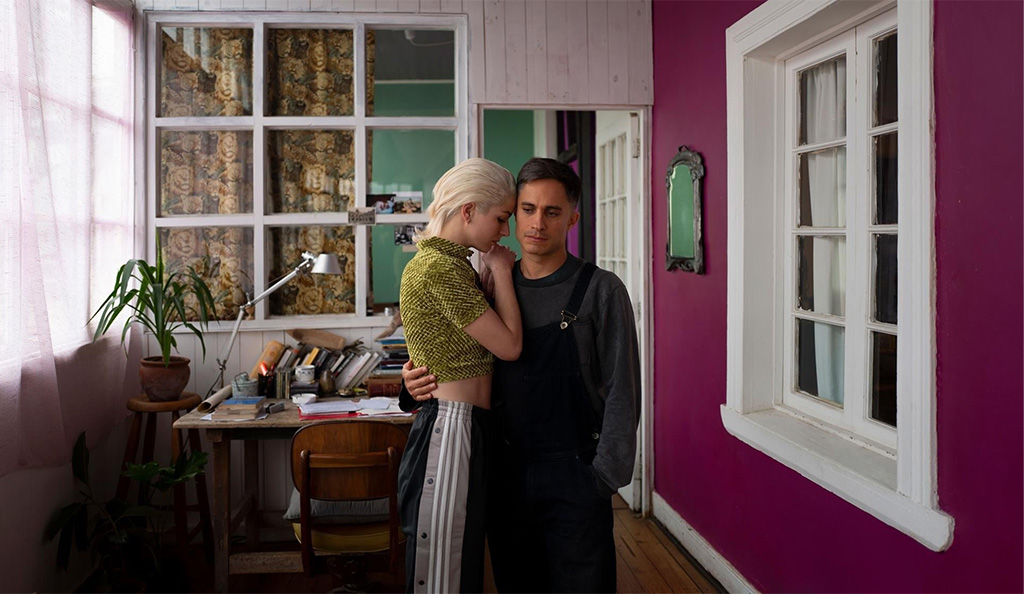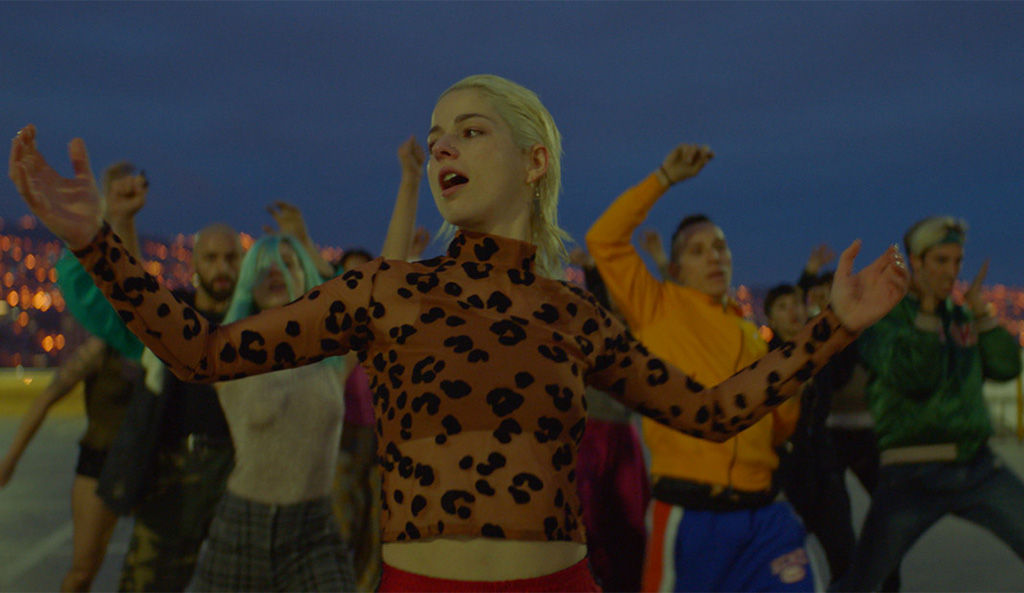Ema film review ★★★★★
Chilean director Pablo Larraín reunites with his No and Neruda star Gael García Bernal in this evocative mix of family drama and dance film
Mariana Di Girolamo in Ema
Directed by: Pablo Larraín
Starring: Mariana Di Girolamo, Cristian Suares, Gael García Bernal, Paola Giannini, Santiago Cabrera
Runtime: 1h47min
Ema premiered at the 2019 Venice Film Festival.
Pablo Larraín’s wonderfully belligerent melodrama is concerned with the manifold nature of performance. How to dance, love, mother, and f*ck, all at once? These duties bleed into one another for Ema (Mariana Di Girolamo, compelling), the insatiable and virile title character who, in desperate circumstances, must play several roles.
Clad in waxed denim and with peroxide hair, she employs her performing arts and wayward bohemianism in service of something more determined: to regain custody of her adopted child Polo (Cristian Suarez). The ends don’t simply justify the means; the hedonistic process is essential to the result.
Ema’s estranged husband and co-dancer Gastón (Gael García Bernal) is a captivating avatar for impotence, a bystander in his lost love’s quest for meaning, a sufferer of inverted Oedipal jealousy. Their domestic strife is portrayed through stark portraits that imply criminal interrogations.
The ravaged couple long for their son, whom they have abandoned to social services after his violent, macabre indiscretions. Whether Polo is a misunderstood young boy or an innate psychopath is left satisfyingly unclear. All that remains is the agonising detritus.

Striking and fastidious, the film sustains a complex marriage between its narrative ambiguities and stylised compositions. Guillermo Calderón and Alejandro Moreno’s snaking screenplay offsets Larraín’s mostly abstract direction, as theatrical sequences suggestively inhibit story progression.
Many scenes function as intervals that warp our sense of an ending, producing a sensory stream of dramatic deferrals. Character motives seem opaque, that is, until the pure maternal moment unfurls into view.
Choreographer Jose Luís Vidal elegantly stages the communal dance shows and rehearsals, these framed by Sergio Armstrong’s acute, embellished photography. Ema’s colleagues form a protective wall and an advisory cohort, a material and worldly Greek chorus.
“You have to do what lizards do,” she is implored. “Get disorientated… f*cked up.” The shot of a flaming traffic light, the emblem of creative destruction, offers an accurate portent for her intentions. Valparaíso, a Chilean seaport dotted with modernist curvatures, funfairs and funiculars, faces its scorched earth.
We are elsewhere preoccupied with heat and light. Ema decants liquid kerosene into jerry cans, ready to set the town ablaze. Bulbs of neon blue and volcanic red alternate and constitute a set of glowing, phosphorescent orbs, under which her dancing troupe is rendered in silhouettes, their outlines forced into uneasy figurations.

Time and space are suspended under the spectacle of these artificial suns. Nicolas Jaar’s ethereal chimes meanwhile transform the reggaeton-inspired dance routines, pleading reassessment of how bodies are supposed to move in the world.
Dance, as it is depicted in the film, reveals the line between light and not-light, the boundary of embodied movement. It functions as an instrument of metamorphosis, as the medium of transmission and transgression. Shadows flatten and coalesce with the rhythm. Ema must express her anguish within a community, in conditions that require perfect poise and control.
This is surely the fascination with the silhouetted body: its ability to translate individual emotional loss into shared corporeal pain.
It’s perhaps no surprise that the dialogue scenes and plot twists seem underpowered in comparison. But Larraín is more concerned with the value of surfaces, the mysteries of the visible. He depicts Ema’s fluid sexual mores in a way that sidesteps pompous prurience and lascivious smirk. Her “banana fingers” are sources of erotic climax and practical application.
Marital infidelity is treated in a dynamic, complicated way: as a force to be manipulated for wider ambitions, as a necessary stride towards unstated objectives, and as a gesture towards a higher form of fidelity, that which undercuts meagre notions of lust and beauty.
Ema is streaming on MUBI now – more info here.
Starring: Mariana Di Girolamo, Cristian Suares, Gael García Bernal, Paola Giannini, Santiago Cabrera
Runtime: 1h47min
Ema premiered at the 2019 Venice Film Festival.
Pablo Larraín’s wonderfully belligerent melodrama is concerned with the manifold nature of performance. How to dance, love, mother, and f*ck, all at once? These duties bleed into one another for Ema (Mariana Di Girolamo, compelling), the insatiable and virile title character who, in desperate circumstances, must play several roles.
Clad in waxed denim and with peroxide hair, she employs her performing arts and wayward bohemianism in service of something more determined: to regain custody of her adopted child Polo (Cristian Suarez). The ends don’t simply justify the means; the hedonistic process is essential to the result.
Ema’s estranged husband and co-dancer Gastón (Gael García Bernal) is a captivating avatar for impotence, a bystander in his lost love’s quest for meaning, a sufferer of inverted Oedipal jealousy. Their domestic strife is portrayed through stark portraits that imply criminal interrogations.
The ravaged couple long for their son, whom they have abandoned to social services after his violent, macabre indiscretions. Whether Polo is a misunderstood young boy or an innate psychopath is left satisfyingly unclear. All that remains is the agonising detritus.

Striking and fastidious, the film sustains a complex marriage between its narrative ambiguities and stylised compositions. Guillermo Calderón and Alejandro Moreno’s snaking screenplay offsets Larraín’s mostly abstract direction, as theatrical sequences suggestively inhibit story progression.
Many scenes function as intervals that warp our sense of an ending, producing a sensory stream of dramatic deferrals. Character motives seem opaque, that is, until the pure maternal moment unfurls into view.
Choreographer Jose Luís Vidal elegantly stages the communal dance shows and rehearsals, these framed by Sergio Armstrong’s acute, embellished photography. Ema’s colleagues form a protective wall and an advisory cohort, a material and worldly Greek chorus.
“You have to do what lizards do,” she is implored. “Get disorientated… f*cked up.” The shot of a flaming traffic light, the emblem of creative destruction, offers an accurate portent for her intentions. Valparaíso, a Chilean seaport dotted with modernist curvatures, funfairs and funiculars, faces its scorched earth.
We are elsewhere preoccupied with heat and light. Ema decants liquid kerosene into jerry cans, ready to set the town ablaze. Bulbs of neon blue and volcanic red alternate and constitute a set of glowing, phosphorescent orbs, under which her dancing troupe is rendered in silhouettes, their outlines forced into uneasy figurations.

Time and space are suspended under the spectacle of these artificial suns. Nicolas Jaar’s ethereal chimes meanwhile transform the reggaeton-inspired dance routines, pleading reassessment of how bodies are supposed to move in the world.
Dance, as it is depicted in the film, reveals the line between light and not-light, the boundary of embodied movement. It functions as an instrument of metamorphosis, as the medium of transmission and transgression. Shadows flatten and coalesce with the rhythm. Ema must express her anguish within a community, in conditions that require perfect poise and control.
This is surely the fascination with the silhouetted body: its ability to translate individual emotional loss into shared corporeal pain.
It’s perhaps no surprise that the dialogue scenes and plot twists seem underpowered in comparison. But Larraín is more concerned with the value of surfaces, the mysteries of the visible. He depicts Ema’s fluid sexual mores in a way that sidesteps pompous prurience and lascivious smirk. Her “banana fingers” are sources of erotic climax and practical application.
Marital infidelity is treated in a dynamic, complicated way: as a force to be manipulated for wider ambitions, as a necessary stride towards unstated objectives, and as a gesture towards a higher form of fidelity, that which undercuts meagre notions of lust and beauty.
Ema is streaming on MUBI now – more info here.
TRY CULTURE WHISPER
Receive free tickets & insider tips to unlock the best of London — direct to your inbox
| What | Ema film review |
| When |
01 May 20 – 01 May 21, WATCH ON MUBI NOW |
| Price | £ determined by cinemas |
| Website | Click here for more information |